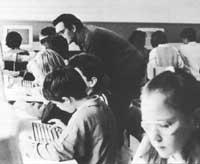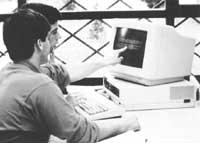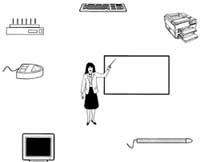New technologies for teaching
The history of computer use has been linked to the development of expensive technology. The first computers appeared in the United States around 1945, more than useful and spectacular. Despite their high price, they were not very reliable and their application was limited to the field of specialists.
This is easy to understand if we consider the following. Engineers and scientists who used the computer to introduce their programs used the only format (the machine language) that comprised the machine. They worked with endless series of zeros and one, loaded with errors, introduced through a heavy and laborious process.

We can say that the evolution of computing and the improvement of interfaces (communication between man and machine) have been developed in parallel. Since the year 70, the halo of esotericism surrounding computer science began to disappear with the appearance of other more natural media.
The democratization and openness to the public of computer science has been accompanied by the emergence of a real socio-economic phenomenon, the microcomputer, a system of multiple applications.
Interest in computer science is growing, as its application is spreading to almost all professions, including teaching. The word OLI (Computer Assisted Teaching) indicates the process of exchange of information that the student performs with the computer.
The integration of the technological model has had many criticisms in the educational process. The strictest question the pedagogical value of these techniques and see the disappearance of teachers closer and closer. According to them, the classroom will become a place of play in which a device capable of representing the futuristic audacity for war replaces the protagonism of the students.
The role of these new technologies in the education system must be dared. In this daring all participants, institutions, students, parents and teachers will have something to say.
If necessary, the first thing the teacher asks himself is do I have to learn computer science?
Undoubtedly, in the near future most professions will be fully computerized. Therefore, it seems normal that knowledge of basic computer concepts helps us understand the environment. In the opinion of many futuristic sociologists, just as the current society is divided into two parts (those who know how to read and those who are not literate), in 2000, the distribution will be as follows: those who use computer science and those who do not have this knowledge.

Following this reasoning, it is applauded to take advantage of the resources that new technologies offer to teaching. But we cannot ask the teacher to become a computer scientist. This approach can break any pedagogical initiative. Fortunately, if there are currently man-machine media (the interfaces mentioned), it is easy to exchange data with the machine without knowing the internal processes. The trends of this type of systems are directed towards “friendly” environments (Windows, Multimedia, etc. ). ).
Audiovisual media
The forecasts we had in the traditional audiovisual field have not been fully fulfilled, but today we can see the push of information technology. The limits of the few graphic possibilities or the primitive systems of sending, storing and presenting data have been left behind. Computer, slide projector, mouse, stylus, etc. is able to manage it. Conversation peripherals have also evolved a lot and today there is a wide variety, from a simple keyboard to sophisticated voice synthesizers. In any case, the objective of this evolution or development is that the exchange of information between the human being and the machine is becoming more and more natural; that communication is done through the eyes, touch and ear.
Hardware is becoming increasingly economical and is spreading more to the educational field. There are numerous image and sound manipulation peripherals on the market. The teacher can offer verbal explanations that he has previously saved on a disc while presenting still or animated images digitalized using a simple domestic camcorder.
The computer is able to store large amounts of information and present it in an attractive way, and new educational approaches must take advantage of this surprising capacity.
Ways of teaching staff

The current supply of materials at OLI is not broad. The bibliography is also deficient when compared with abundant theoretical and practical material from any other field of computer science.
Some households market programs that can be qualified as good quality. With these programs the subject is developed through small doses of information and screens illustrated with graphics. The student's job is to assimilate the content and answer the questions asked. According to these answers, the program will follow the subject, return to the previous point or offer the explanation in another way. The computer will become a real research tool in the hands of the student.
We must state that the duty of the teacher is irreplaceable, since he is responsible for the work of orienting the subject towards the important points, solving the doubts that arise and promoting debates in class.
Buying such a pack is an option for the school. However, in our opinion, it should be a resource that helps teachers prepare the subjects, since the material purchased normally does not fully meet the needs of a group of students.
Development of an OLI project
The most used resources in the preparation of OLI subjects are programming languages such as BASIC or PASCAL. There are also some OLI specific languages such as the PILOT language.
There are also built-in packages to represent screens or create stories. With them you can prepare interactive sessions with attractive graphic resources.

It is clear that the characteristics of the work will be defined according to objectives and needs. We will choose according to functional analysis: course development, questions-response, game type, etc. A research design should try to create the necessary conditions to give the student their own criteria.
Once the subject is prepared, the suitability of the work is tested in practice and the mistakes are corrected. Many times, the need to respond to the examples given by the student implies a rethinking of the complete design.
Future LP
As for the physical support (hardware), in addition to the improvement by miniaturization, a continuous summary of costs is foreseen, in which the machines will be increasingly accessible for the budgets of the centers.
As for the logical support, there is still much to be done in human/machine communication. Currently only very advanced systems support open answers. In this fruitful field of research we will see great advances in the near future.
We also expect the generation of more powerful author languages and systems, in which the entire process will be carried out by teachers from the beginning to the end.
With all this, we hope that the number of teachers who will consider the computer as a tool to create new things will be increasing.
Buletina
Bidali zure helbide elektronikoa eta jaso asteroko buletina zure sarrera-ontzian











